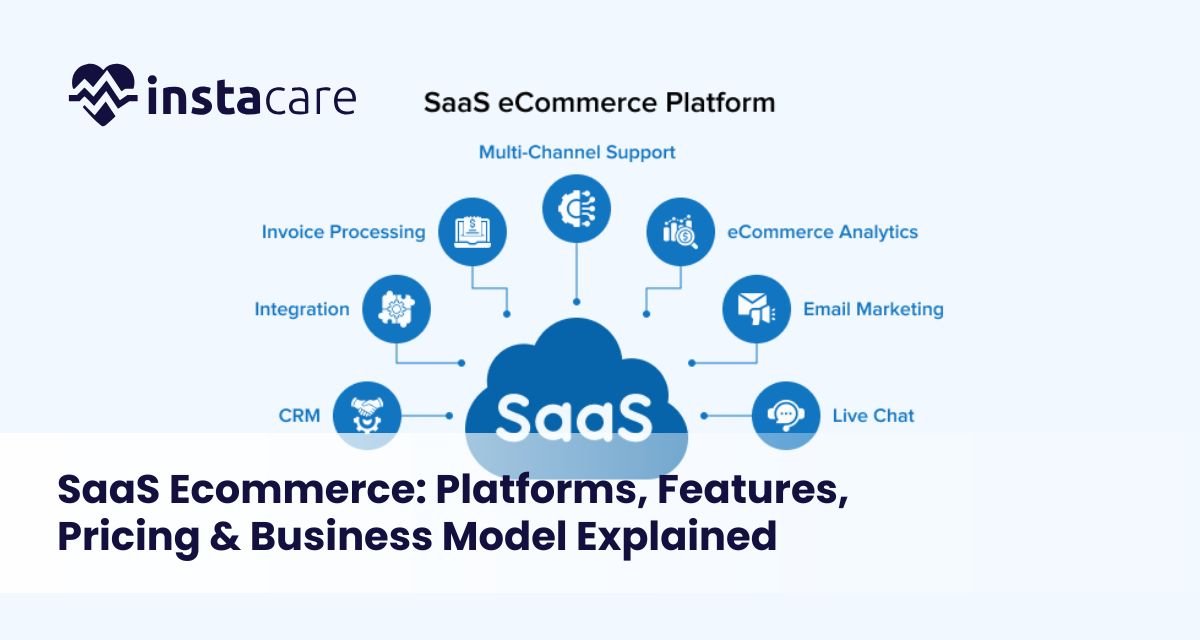Last updated on Tuesday, 18, November, 2025
Table of Contents
SaaS Ecommerce: Platforms, Features, Pricing & Business Model Explained
The evolution of SaaS ecommerce platforms has changed the way online stores are designed, operated, and grown by businesses. As compared to traditional self-hosted method, Software as a Service (SaaS) ecommerce platforms provide cloud-based technology that is fast, scalable, and affordable. Whether small business enterprise or multi-national company, companies now utilize best SaaS ecommerce software for automating processes, saving cost, and providing improved customer experience.
What is SaaS Ecommerce?
SaaS ecommerce is software that runs on the cloud and allows companies to create, run, and host web stores without having to deal with backend infrastructure or hosting on the company’s website. SaaS ecommerce differs from open-source ecommerce alternatives that require an enormous amount of technical expertise and server management since custom SaaS ecommerce solutions offer a plug-and-play solution.
SaaS ecommerce business model is typically subscription-based where the customers pay an annual or monthly fee to access features, updates, and support on the website. The model provides business enterprises with the cost-per-year or cost-per-month model and eliminate in-house IT overhead. Business enterprises also enjoy the ease of easy scalability as the customers grow because it is cloud-based.
How does SaaS Ecommerce work?
SaaS ecommerce stores are hosted on the cloud. Sellers own the software, security, updates, and scalability. Sellers host and manage the software, security, updates, and scalability. Clients access their ecommerce dashboards via web browsers where clients’ products, inventories, customers’ orders, and payments are configurable.
Ease, scalability, security, and administration in SaaS ecommerce architecture are all offered by:
- Cloud Hosting & Storage: Offers data security, quick access, and scalability.
- Security & Compliance Layers: Places itself between cyber assaults and supports global data regulation compliance.
- Scalable Performance Management: Assists with managing high traffic via sale surges and spikes.
- Integrated Payment Gateways: Facilitates secure payment with multiple streams of checkout.
- Third-party App Integrations: Extends more functionality to the platform via extensions and APIs.
Ecommerce SaaS websites also contain APIs for customization, templates, and tools through which businesses can tailor the workflow and storefront without extensive coding. Ecommerce SaaS integration of marketing software, CRMs, and ERPs also improves the operational efficiency and customer interaction.
Book Your Free Marketing Consultation
Key Features of SaaS Ecommerce Platforms
- User-Friendly Interface: Graphical dashboards, drag-and-drop editors, and intuitive navigation facilitate easy installation and everyday use.
- Mobile-Responsive Design: Provides seamless shopping experience across all devices, which is a must in today’s mobile-first culture age.
- Secure Payment Gateways: Offers multi-payment option with built-in compliance (PCI-DSS), fraud protection, and secure checkout process.
- Inventory Management: Real-time reporting, automated alerts, central product management, and seamless integration with supply chain systems.
- Scalable Hosting: Holds the burst traffic without giving up on performance, including uptime during holiday offers or flash deals.
- In-Built Marketing Tools: SEO optimization, email marketing, coupon codes, social integration, and complete analytics dashboards.
- Third-Party Application Support: Integration with logistics companies, CRMs, ERPs, marketplaces, and business apps.
- Multi-Channel Selling: Enables selling from your site, online marketplaces like eBay and Amazon, and social commerce storefronts like Facebook and Instagram.
- Customization & Personalization Features: Theme libraries, personal templates, and API access for the extreme customization.
- Customer Support & Community Access: 24/7 customer support and access to a users’ community for the sharing of tips and insight.
Best SaaS Ecommerce Solutions
- Shopify: Most appropriate for small startups and SMEs in need of a SaaS ecommerce that is simple to implement but scalable with huge apps and integrations.
- BigCommerce: Recognized for innovative B2B SaaS ecommerce functionality, robust SEO functionality, and excellent multi-channel selling functionality.
- Wix Ecommerce: Most suitable for small businesses that seek affordable, tailored SaaS ecommerce with advanced design functionality.
- Squarespace Commerce: Most suitable for innovative businesses that need contemporary design and user-friendly, built-in marketing functionality.
- Salesforce Commerce Cloud: Enterprise-class SaaS ecommerce with comprehensive CRM integration and large-scale scalability for global enterprises.
- Adobe Commerce (Magento SaaS Edition): Offers the might of Magento combined with the ease of SaaS to large enterprises requiring custom solutions.
- Volusion: Most suitable for those businesses requiring SEO functionality as part of the solution and heavy data analysis.
- Shift4Shop: Offers a free version with reasonable features, best for extremely small startups with extremely tiny budgets.
SaaS Ecommerce Pricing Models
SaaS ecommerce pricing is feature, size, and target market-based. Some of the most common models are:
- Tiered Pricing: Several plans with product limits, feature access, and bandwidth.
- Per Transaction Fee: Minimal percentage of sales charge in addition to the subscription fee, generally for the likes of Shopify.
- Flat Monthly Fee: Fixed monthly charges regardless of the level of sales, for those firms that want the expenses to be as stable.
- Enterprise Custom Plans: For big businesses that require more features, priority support, and custom integrations.
Examples of base prices:
- Shopify Basic: $39/month
- BigCommerce Standard: $39 per month
- Wix Business Basic: $27/month
- Squarespace Commerce Basic: $36/month
- Salesforce Commerce Cloud: Custom pricing
Prices rise with usage, additional ecommerce SaaS features, or items sold, so it is important that businesses compare solutions that fit tomorrow’s and today’s needs.
Advantages and Disadvantages of SaaS Commerce
Advantages:
- Low startup cost and constant recurring fees.
- Easy to install with minimal technical skills needed.
- Vendor conducts auto-updating, security patches and hosting
- scalable ecommerce SaaS solutions that expand with your business
- Easily accessible applications, add-ons and support.
- Platform updated regularly at no additional fee.
- Support for multiple devices for mobile management on the go.
Disadvantages are:
- Limited personalization options particularly for uncommon business needs
- Occasional subscription paid over time accumulates.
- Vendor lock-in is the hindrance of being able to change platforms or transfer data.
- Transaction charges in certain platforms impact the bottom line.
- Dependence on the vendor for platform functionality and availability.
Conclusion
SaaS ecommerce has revolutionized online purchasing to be scalable, accessible, and manageable for any sized organization. Whether as a huge company who needs to scale your ecommerce SaaS or a small company starting your first online business, it is important to know the SaaS ecommerce architecture, pricing, and features. Through effective platform selection, businesses can ride ecommerce SaaS trends, simplify operations, and enhance the customer experience.
SaaS ecommerce solutions are a real-world substitute for open-source ecommerce with flexibility without the cost of infrastructure ownership. With headless SaaS models, businesses are offered unprecedented customization while still receiving all of the operational benefits of SaaS. B2B SaaS ecommerce solutions even allow businesses to perform mass-scale operations, connect to business systems, and scale quickly.
FAQs
Q1: What is the difference between open-source ecommerce sites and SaaS?
SaaS vs open source ecommerce are different. SaaS ecommerce websites are hosted and managed by a vendor, offering ease, scalability, and reduced initial expense. Open-source ecommerce websites are hosted internally, offer more control over personalization but require technical expertise and committed resources.
Q2: What are the examples of ecommerce SaaS
Some of the most prevalent ecommerce SaaS examples are Shopify, BigCommerce, Wix, Salesforce Commerce Cloud, Adobe Commerce Cloud, Volusion, and Shift4Shop. ecommerce SaaS comes in all shapes and sizes for every company, from small business startups to big business corporations.
Q3: What is headless ecommerce SaaS?
Headless ecommerce SaaS provides the feature of decoupling frontend and backend so that companies can provide highly personalized user experiences without undermining SaaS backend benefits. Top ecommerce SaaS companies requiring custom customer experience without undermining run efficiency of a SaaS platform can benefit from this deployment type.



